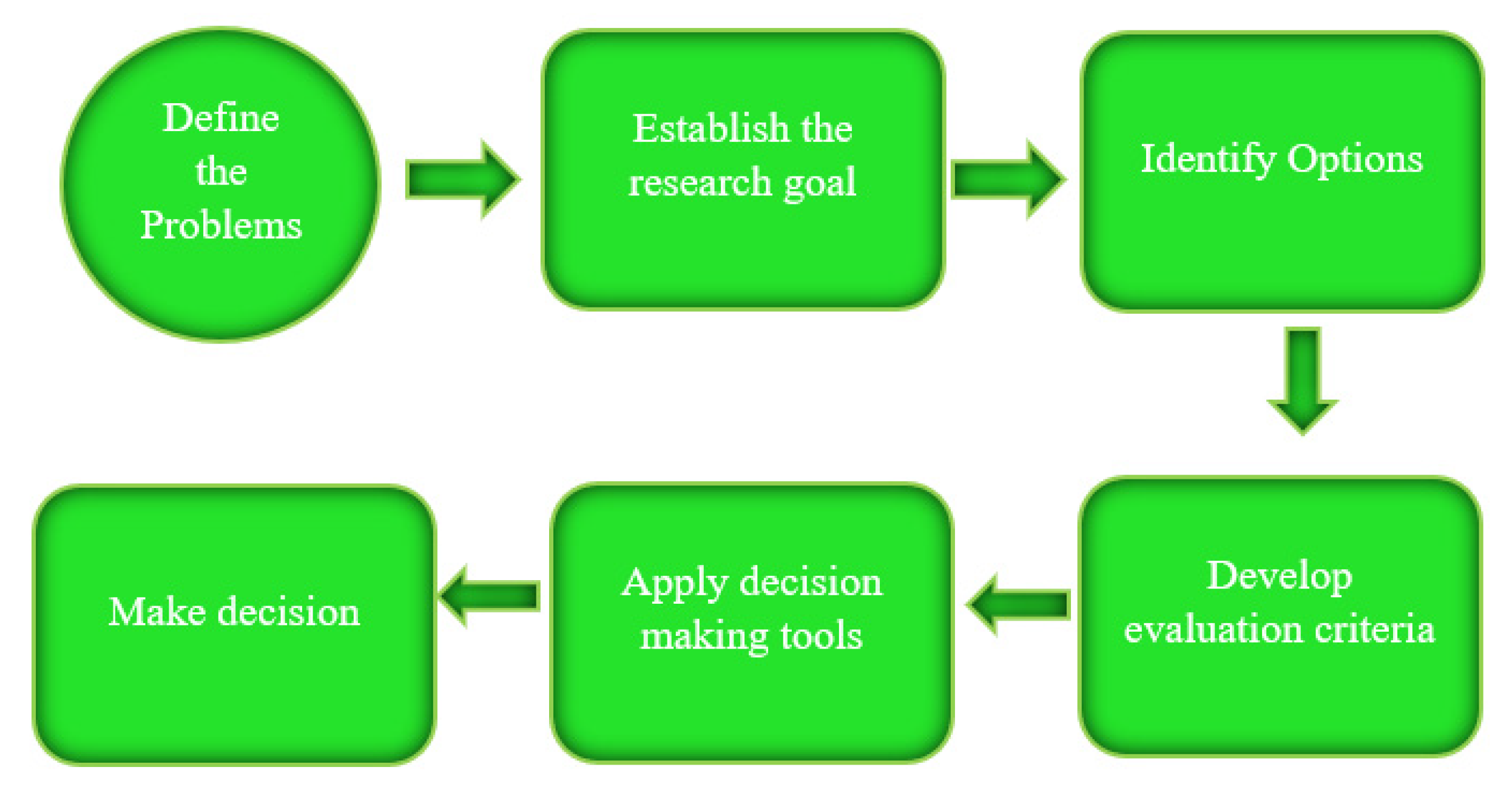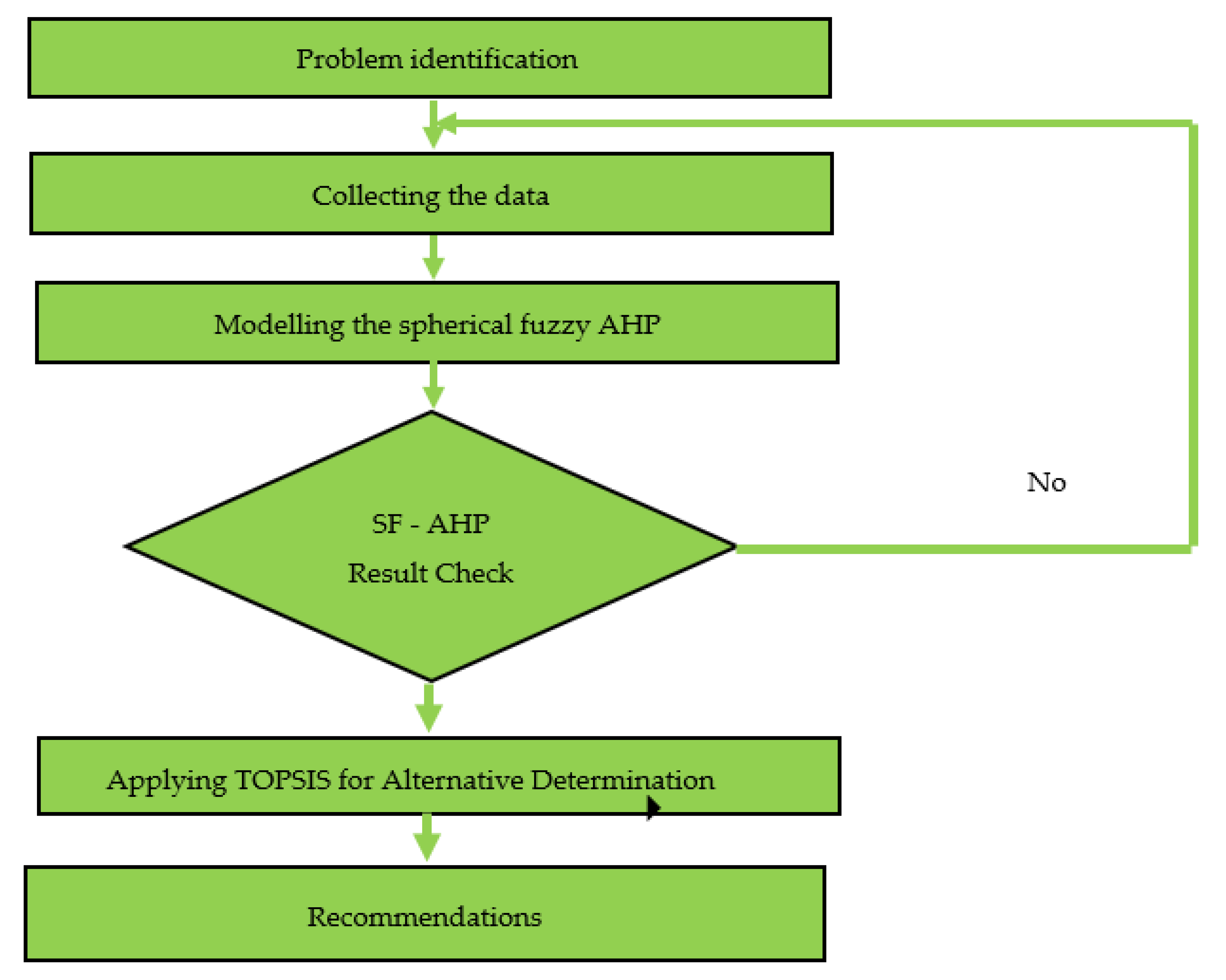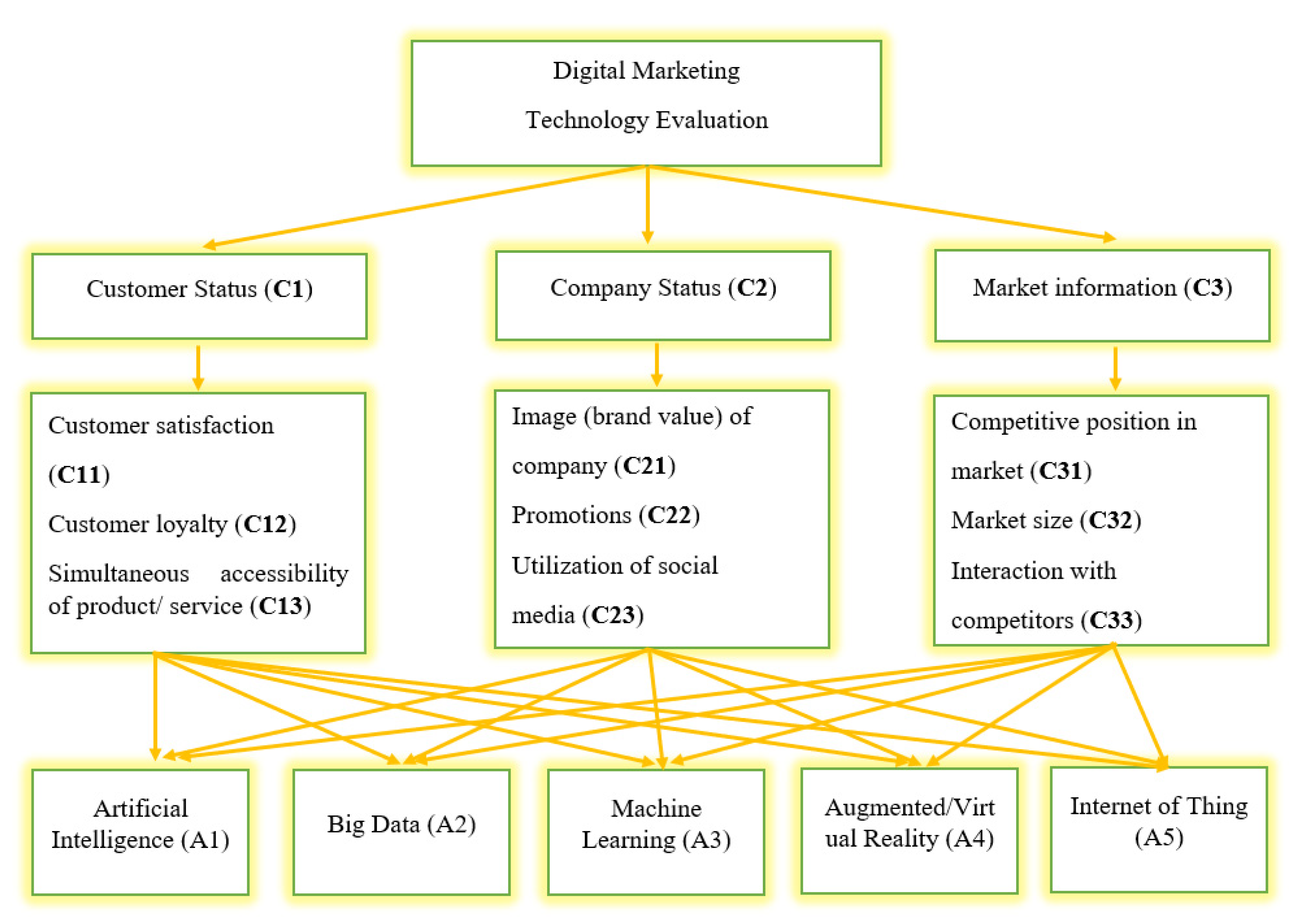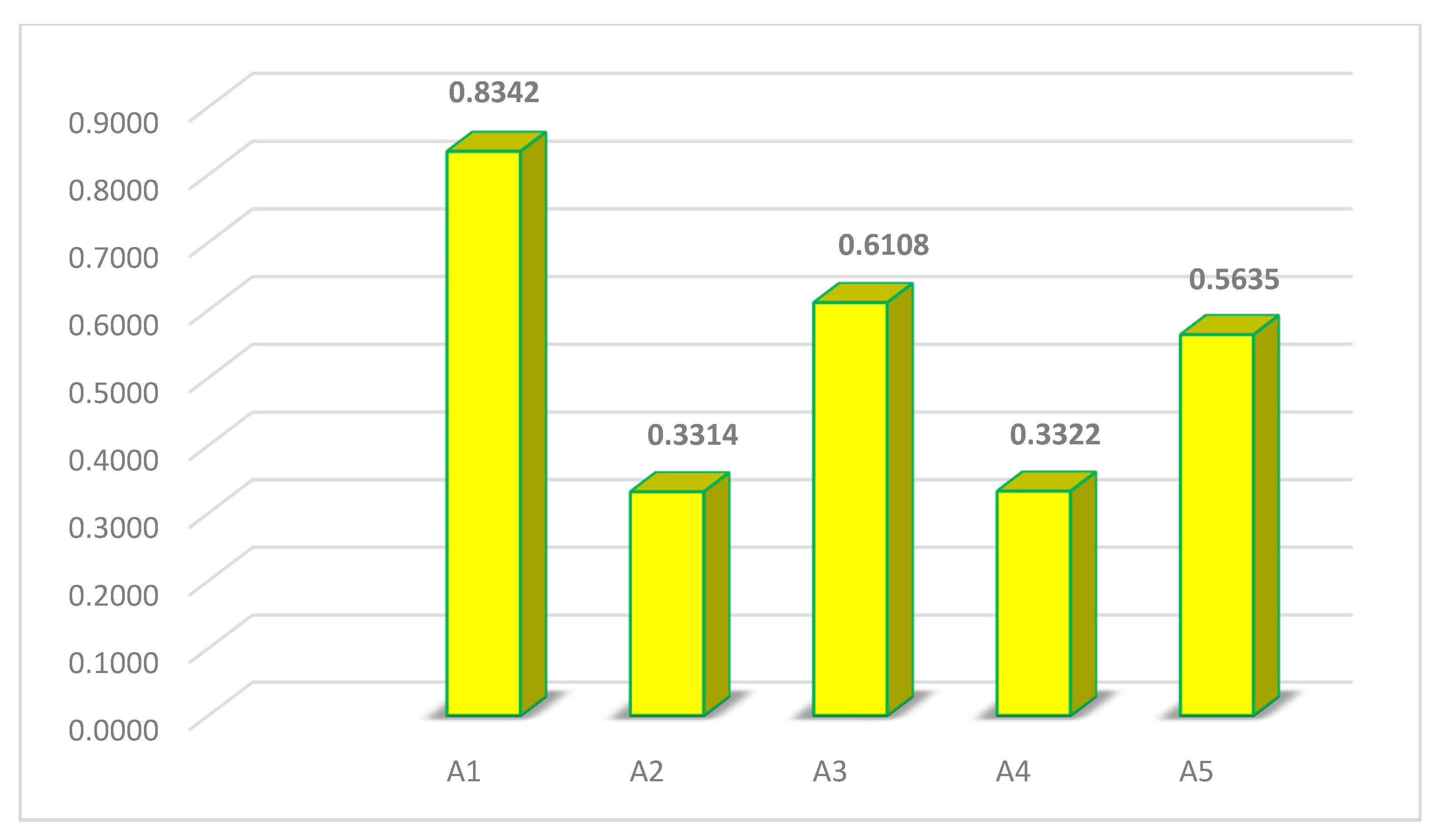Evaluation of Digital Marketing Technologies with Fuzzy Linguistic MCDM Methods
Abstract
:1. Introduction
2. Literature Review
3. Methodology
3.1. Theory of Spherical Fuzzy Sets
3.2. Model of the Spherical Fuzzy Analytic Hierarchy Process (SF-AHP)
3.3. Technique for Order Preference by Similarity to Ideal Solution (TOPSIS)
4. Case Study
5. Conclusions
- ✓
- The proposed fuzzy MCDM model is the first digital marketing technology selection model in Vietnam. We discovered this by interviewing experts and reviewing the literature.
- ✓
- Second, this is the first study to provide a case study on evaluating marketing technology utilizing the approach proposed by the combination of SF-AHP and TOPSIS models.
- ✓
- The results of this study can be valuable guidance in the alternatives assessment and selection sector, not only for the marketing sector but also for decision-makers and investors in other industries.
Author Contributions
Funding
Acknowledgments
Conflicts of Interest
References
- Xu hướng ngành Digital Marketing Việt Nam 2021 (Digital Marketing Industry Trends 2021 in Vietnam). Available online: https://vietnamdigital.vn/blog/xu-huong-nganh-digital-marketing-viet-nam-2021/ (accessed on 18 August 2021).
- Công nghệ số thay đổi diện mạo của ngành truyền thông tại Việt Nam (Digital Transformation is Impacting the Media Industry in Vietnam). Available online: https://advertisingvietnam.com/cong-nghe-so-thay-doi-dien-mao-cua-nganh-truyen-thong-tai-viet-nam (accessed on 18 August 2021).
- Trí tuệ nhân tạo và ứng dụng trong hoạt động marketing (Artificial Intelligence and Its Application in Marketing Activities). Available online: https://senplus.vn/tri-tue-nhan-tao-ai-va-ung-dung-trong-hoat-dong-marketing.html (accessed on 18 August 2021).
- AI sẽ thay đổi Digital Marketing thế nào trong năm 2021 (How AI Will Change Digital Marketing in 2021). Available online: https://advertisingvietnam.com/ai-se-thay-doi-digital-marketing-the-nao-trong-nam-2021-p15989 (accessed on 18 August 2021).
- Hilbert, M.; López, P. The world’s technological capacity to store, communicate, and compute information. Science 2011, 332, 60–65. [Google Scholar] [CrossRef] [PubMed] [Green Version]
- Ho Phuong Thao. Big Data và những ứng dụng tuyệt vời vào ngành Marketing thời đại 4.0 (Big Data and Great Applications in the Industry 4.0 Era of Marketing). Available online: https://123job.vn/bai-viet/big-data-va-nhung-ung-dung-tuyet-voi-vao-nganh-marketing-thoi-dai-40-937.html (accessed on 18 August 2021).
- 7 xu hướng ứng dụng marketing automation cho doanh nghiệp (7 Marketing Automation Application Trends for Businesses). Available online: https://www.navee.asia/kb/7-xu-huong-ung-dung-marketing-automation-cho-doanh-nghiep/ (accessed on 18 August 2021).
- Ứng dụng xu hướng tương tác thực tế—Augmented Reality vào Marketing. Available online: https://www.brandsvietnam.com/congdong/topic/3529-Ung-dung-xu-huong-tuong-tac-thuc-te-Augmented-Reality-vao-marketing (accessed on 18 August 2021).
- Augmented Reality là gì? (What is Augmented Reality?). Available online: https://webdoctor.vn/augmented-reality-la-gi-xu-huong-tuong-tac-thuc-te-thoi-dai-so/ (accessed on 18 August 2021).
- Brooks, H. The relationship between science and technology. Res. Policy 1994, 23, 477–486. [Google Scholar] [CrossRef]
- Mukul, E.; Büyüközkan, G.; Güler, M. Evaluation of digital marketing technologies with MCDM methods. In Proceedings of the 6th International Conference on New Ideas in Management, Economics and Accounting, Paris, France, 19–21 April 2019. [Google Scholar]
- Erdoğan, M.; Karaşan, A.; Kaya, İ.; Budak, A.; Çolak, M. A fuzzy based MCDM methodology for risk evaluation of cyber security technologies. In Proceedings of the INFUS 2019 Conference, Istanbul, Turkey, 23–25 Junly 2019; Springer: Cham, Switzerland, 2019. [Google Scholar]
- Chang, S.C.; Chang, H.H.; Lu, M.T. Evaluating industry 4.0 technology application in SMES: Using a Hybrid MCDM Approach. Mathematics 2021, 9, 414. [Google Scholar] [CrossRef]
- Samanlioglu, F.; Burnaz, A.N.; Diş, B.; Tabaş, M.D.; Adıgüzel, M. An Integrated fuzzy best-worst-TOPSIS method for evaluation of hotel website and digital solutions provider firms. Adv. Fuzzy Syst. 2020, 2020, 8852223. [Google Scholar] [CrossRef]
- Imanova, G.E.; Imanova, G. Digital marketing technologies selection under Z-environment. In Proceedings of the 14th International Conference on Theory and Application of Fuzzy Systems and Soft Computing—ICAFS-2020 , Istanbul, Turkey, 28–30 October 2020; Springer: Cham, Switzerland, 2020. [Google Scholar]
- Mahdiraji, H.A.; Kazimieras Zavadskas, E.; Kazeminia, A.; Abbasi Kamardi, A. Marketing strategies evaluation based on big data analysis: A Clustering-MCDM Approach. Econ. Res. Ekon. Istraživanja 2019, 32, 2882–2892. [Google Scholar] [CrossRef] [Green Version]
- Hsieh, M.Y. Employing MCDM methodology to verify correlationship between social media and service quality in the dynamic m-commerce era. J. Internet Technol. 2018, 19, 539–553. [Google Scholar]
- Tang, M.T.; Tzeng, G.H.; Wang, S.W. A hierarchy fuzzy MCDM method for studying electronic marketing strategies in the information service industry. J. Int. Inf. Manag. 1999, 8, 1. [Google Scholar]
- Ajripour, I. Applying MCDM Technique in analyzing the effect of promotion items based on online shopping factors: A Case Study. In European Union’s Contention in the Reshaping Global Economy; University of Szeged: Szeged, Hungary, 20–21 March 2020. [Google Scholar]
- Khatwani, G.; Das, G. Evaluating combination of individual pre-purchase internet information channels using hybrid fuzzy MCDM technique: Demographics as Moderators. Int. J. Indian Cult. Bus. Manag. 2016, 12, 28–49. [Google Scholar] [CrossRef]
- Joshi, K.P.; Alur, S. Enhanced selling on digital space via matching buyer and seller preferences using fuzzy MCDM method. In Fuzzy Optimization and Multi-Criteria Decision Making in Digital Marketing; IGI Global: Hershey, PA, USA, 2016. [Google Scholar]
- Büyüközkan, G.; Güler, M. Analysis of companies’ digital maturity by hesitant fuzzy linguistic MCDM methods. J. Intell. Fuzzy Syst. 2020, 38, 1119–1132. [Google Scholar] [CrossRef]
- Kwak, N.K.; Lee, C.W.; Kim, J.H. An MCDM model for media selection in the dual consumer/industrial market. Eur. J. Oper. Res. 2005, 166, 255–265. [Google Scholar] [CrossRef]
- Kaltenrieder, P.; D’Onofrio, S.; Portmann, E. Applying the fuzzy analytical network process in digital marketing. In Fuzzy Optimization and Multi-Criteria Decision Making in Digital Marketing; IGI Global: Hershey, PA, USA, 2016. [Google Scholar]
- Lu, M.T.; Lin, S.W.; Tzeng, G.H. Improving RFID adoption in Taiwan’s healthcare industry based on a DEMATEL technique with a hybrid MCDM model. Decis. Support Syst. 2013, 56, 259–269. [Google Scholar] [CrossRef]
- Boopathy, P.; Deepa, N. Decision analysis in financial marketing using multi-criteria decision-making methods. In Sustainability Reporting, Ethics, and Strategic Management Strategies for Modern Organizations; IGI Global: Hershey, PA, USA, 2021. [Google Scholar]
- Gündoğdu, F.K.; Kahraman, C. Spherical fuzzy sets and spherical fuzzy TOPSIS method. J. Intell. Fuzzy Syst. 2019, 36, 337–352. [Google Scholar] [CrossRef]
- Yager, R. Pythagorean fuzzy subsets. In Proceedings of the 2013 Joint IFSA World Congress and NAFIPS Annual Meeting (IFSA/NAFIPS), Edmonton, AB, Canada, 24–28 June 2013; pp. 57–61. [Google Scholar]
- Gündoğdu, F.K.; Kahraman, C. A novel spherical fuzzy analytic hierarchy process and its renewable energy application. Soft Comput. 2019, 24, 4607–4621. [Google Scholar] [CrossRef]
- Hwang, C.L.; Yoon, K. Multiple Attribute Decision Making: Methods and Applications; Springer: New York, NY, USA, 1981. [Google Scholar]




| Score Index (PI) | ||
|---|---|---|
| Absolute high significance (AH) | (0.9, 0.1, 0.0) | 9 |
| Very high significance (VH) | (0.8, 0.2, 0.1) | 7 |
| High significance (HS) | (0.7, 0.3, 0.2) | 5 |
| Slightly high significance (SM) | (0.6, 0.4, 0.3) | 3 |
| Equally significance (ES) | (0.5, 0.4, 0.4) | 1 |
| Slightly low significance (SL) | (0.4, 0.6, 0.3) | 1/3 |
| Low significance (LS) | (0.3, 0.7, 0.2) | 1/5 |
| Very low significance (VL) | (0.2, 0.8, 0.1) | 1/7 |
| Absolutely low significance (AL) | (0.1, 0.9, 0.0) | 1/9 |
| Category | Profile | No. of Experts |
|---|---|---|
| Education level | BSc in Marketing/BSc in Information technology/Business administration | 9 |
| MSc in Marketing/BSc in Information technology/Business administration | 4 | |
| PhD in Marketing/BSc in Information technology/Business administration | 2 | |
| Work Experience | Between five to ten years | 3 |
| More than ten years | 12 | |
| Age | Between 20- to 30-year-old | 1 |
| More than 30-year-old | 14 |
| Left Criteria Is Greater | Right Criteria Is Greater | |||||||||
|---|---|---|---|---|---|---|---|---|---|---|
| Dimension | AH | VH | HS | SM | ES | SL | LS | VL | AL | Dimension |
| C11 | 4 | 3 | 2 | 1 | 3 | 1 | 1 | C12 | ||
| C11 | 4 | 3 | 2 | 1 | 5 | C13 | ||||
| C11 | 3 | 2 | 1 | 4 | 5 | C21 | ||||
| C11 | 3 | 4 | 1 | 1 | 3 | 2 | 1 | C22 | ||
| C11 | 3 | 4 | 4 | 2 | 1 | 1 | C23 | |||
| C11 | 3 | 3 | 3 | 4 | 1 | 1 | C31 | |||
| C11 | 2 | 3 | 4 | 1 | 2 | 3 | C32 | |||
| C11 | 3 | 4 | 1 | 1 | 3 | 3 | C33 | |||
| C12 | 3 | 4 | 3 | 3 | 2 | C13 | ||||
| C12 | 1 | 3 | 4 | 5 | 1 | 1 | C21 | |||
| C12 | 2 | 3 | 4 | 5 | 1 | C22 | ||||
| C12 | 2 | 3 | 4 | 5 | 1 | C23 | ||||
| C12 | 3 | 4 | 5 | 2 | 1 | C31 | ||||
| C12 | 3 | 4 | 5 | 2 | 1 | C32 | ||||
| C12 | 3 | 4 | 2 | 5 | 1 | C33 | ||||
| C13 | 3 | 4 | 5 | 2 | 1 | C21 | ||||
| C13 | 2 | 4 | 2 | 1 | 5 | 1 | C22 | |||
| C13 | 3 | 4 | 3 | 2 | 2 | 1 | C23 | |||
| C13 | 1 | 3 | 4 | 4 | 3 | C31 | ||||
| C13 | 1 | 4 | 3 | 3 | 4 | C32 | ||||
| C13 | 3 | 2 | 2 | 4 | 2 | 2 | C33 | |||
| C21 | 4 | 5 | 4 | 1 | 1 | C22 | ||||
| C21 | 3 | 3 | 4 | 2 | 1 | 1 | 1 | C23 | ||
| C21 | 4 | 2 | 3 | 1 | 1 | 4 | C31 | |||
| C21 | 3 | 3 | 4 | 2 | 2 | 1 | C32 | |||
| C21 | 4 | 5 | 1 | 3 | 2 | C33 | ||||
| C22 | 4 | 3 | 3 | 1 | 1 | 3 | C23 | |||
| C22 | 2 | 2 | 2 | 4 | 2 | 3 | C31 | |||
| C22 | 3 | 4 | 3 | 3 | 2 | C32 | ||||
| C22 | 2 | 2 | 3 | 4 | 3 | 1 | C33 | |||
| C23 | 4 | 3 | 4 | 2 | 2 | C31 | ||||
| C23 | 4 | 5 | 1 | 1 | 2 | 2 | C32 | |||
| C23 | 3 | 4 | 4 | 1 | 3 | C33 | ||||
| C31 | 3 | 4 | 3 | 2 | 3 | C32 | ||||
| C31 | 2 | 3 | 4 | 5 | 1 | C33 | ||||
| C32 | 3 | 4 | 5 | 2 | 1 | C33 | ||||
| Criteria | Spherical Fuzzy Weights | Crisp Weights | ||
|---|---|---|---|---|
| C11 | 0.439 | 0.533 | 0.324 | 0.092 |
| C12 | 0.425 | 0.545 | 0.319 | 0.089 |
| C13 | 0.395 | 0.597 | 0.281 | 0.084 |
| C21 | 0.462 | 0.532 | 0.288 | 0.099 |
| C22 | 0.487 | 0.499 | 0.296 | 0.105 |
| C23 | 0.538 | 0.455 | 0.293 | 0.117 |
| C31 | 0.574 | 0.414 | 0.282 | 0.126 |
| C32 | 0.616 | 0.379 | 0.267 | 0.137 |
| C33 | 0.667 | 0.330 | 0.253 | 0.150 |
| A1 | A2 | A3 | A4 | A5 | |
|---|---|---|---|---|---|
| C11 | 0.54976 | 0.42759 | 0.30542 | 0.48868 | 0.42759 |
| C12 | 0.61667 | 0.34259 | 0.47963 | 0.20556 | 0.47963 |
| C13 | 0.44630 | 0.25503 | 0.57382 | 0.51006 | 0.38255 |
| C21 | 0.53692 | 0.20135 | 0.53692 | 0.13423 | 0.60404 |
| C22 | 0.52489 | 0.40825 | 0.46657 | 0.34993 | 0.46657 |
| C23 | 0.44540 | 0.50903 | 0.44540 | 0.38177 | 0.44540 |
| C31 | 0.53882 | 0.47895 | 0.41908 | 0.41908 | 0.35921 |
| C32 | 0.48242 | 0.42212 | 0.48242 | 0.42212 | 0.42212 |
| C33 | 0.53882 | 0.41908 | 0.41908 | 0.47895 | 0.35921 |
| A1 | A2 | A3 | A4 | A5 | |
|---|---|---|---|---|---|
| C11 | 0.05073 | 0.03946 | 0.02818 | 0.04509 | 0.03946 |
| C12 | 0.05504 | 0.03058 | 0.04281 | 0.01835 | 0.04281 |
| C13 | 0.03728 | 0.02130 | 0.04793 | 0.04260 | 0.03195 |
| C21 | 0.05330 | 0.01999 | 0.05330 | 0.01332 | 0.05996 |
| C22 | 0.05514 | 0.04288 | 0.04901 | 0.03676 | 0.04901 |
| C23 | 0.05228 | 0.05975 | 0.05228 | 0.04481 | 0.05228 |
| C31 | 0.06814 | 0.06057 | 0.05300 | 0.05300 | 0.04543 |
| C32 | 0.06610 | 0.05784 | 0.06610 | 0.05784 | 0.05784 |
| C33 | 0.08069 | 0.06276 | 0.06276 | 0.07172 | 0.05379 |
| Alternatives | Si+ | Si- | Ci |
|---|---|---|---|
| A1 | 0.0146 | 0.0735 | 0.8342 |
| A2 | 0.0602 | 0.0299 | 0.3314 |
| A3 | 0.0367 | 0.0576 | 0.6108 |
| A4 | 0.0672 | 0.0334 | 0.3322 |
| A5 | 0.0440 | 0.0567 | 0.5635 |
| Alternatives | TOPSIS with Equal Weights Ci Value | Rank | Proposed MCDM Model Ci Value | Rank |
|---|---|---|---|---|
| A1 | 0.8222 | 1 | 0.8342 | 1 |
| A2 | 0.3061 | 5 | 0.3314 | 5 |
| A3 | 0.6372 | 2 | 0.6108 | 2 |
| A4 | 0.3334 | 4 | 0.3322 | 4 |
| A5 | 0.6058 | 3 | 0.5635 | 3 |
Publisher’s Note: MDPI stays neutral with regard to jurisdictional claims in published maps and institutional affiliations. |
© 2022 by the authors. Licensee MDPI, Basel, Switzerland. This article is an open access article distributed under the terms and conditions of the Creative Commons Attribution (CC BY) license (https://creativecommons.org/licenses/by/4.0/).
Share and Cite
Trung, N.Q.; Thanh, N.V. Evaluation of Digital Marketing Technologies with Fuzzy Linguistic MCDM Methods. Axioms 2022, 11, 230. https://doi.org/10.3390/axioms11050230
Trung NQ, Thanh NV. Evaluation of Digital Marketing Technologies with Fuzzy Linguistic MCDM Methods. Axioms. 2022; 11(5):230. https://doi.org/10.3390/axioms11050230
Chicago/Turabian StyleTrung, Ngo Quang, and Nguyen Van Thanh. 2022. "Evaluation of Digital Marketing Technologies with Fuzzy Linguistic MCDM Methods" Axioms 11, no. 5: 230. https://doi.org/10.3390/axioms11050230
APA StyleTrung, N. Q., & Thanh, N. V. (2022). Evaluation of Digital Marketing Technologies with Fuzzy Linguistic MCDM Methods. Axioms, 11(5), 230. https://doi.org/10.3390/axioms11050230







